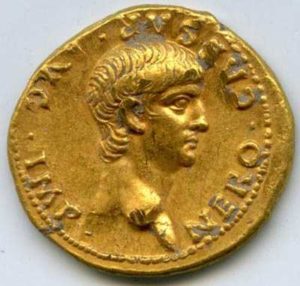
(Biblical Archaeology) — A rare gold coin depicting Roman emperor Nero was unearthed in archaeological excavations just outside the Old City of Jerusalem in Israel.
The coin was found in the excavations of the Mount Zion Project, codirected by Shimon Gibson, Visiting Professor of Archaeology at the University of North Carolina at Charlotte, and James Tabor, Professor of Ancient Judaism and Early Christianity at UNC-Charlotte. This Nero coin is especially significant because it was discovered on a scientific excavation, so its findspot is clear.
The coin, called an aureus—the standard gold coin in ancient Rome, bears on its obverse side (see image above) a portrait of Nero and an inscription reading “NERO CAESAR AVG IMP” (Nero Caesar Augustus Imperator). Nero was Roman emperor from 54 to 68 C.E. On the Nero coin’s reverse side (see example below) appear an oak wreath surrounding the letters “EX S C” (Ex Senatus Consulto—“by order of the Senate”) as well as the inscription “PONTIF MAX TR P III” (Pontifex Maximus Tribunicia Potestas III).
The Nero coin was excavated from rubble near the remains of first-century C.E. villas where members of the Jewish priestly caste may have lived. The Mount Zion Project has been investigating these villas for the last several years.
Continue reading this story >>
Become a Christian News Network Supporter...


